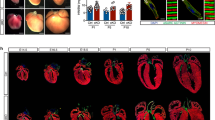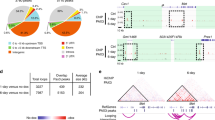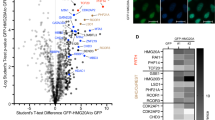Abstract
The high mobility group (HMG) of nuclear proteins regulates expression of many genes through architectural remodelling of the chromatin structure, and formation of multiprotein complexes on promoter/enhancer regions. This leads to the active transcription of their target genes1,2,3. Here we show that HMGA2, a member of the HMGA sub-family of HMG proteins, has a critical function in cardiogenesis. Overexpression of HMGA2 enhanced, whereas siRNA-mediated knockdown of HMGA2 blocked, cardiomyocyte differentiation of the embryonal carcinoma cell line P19CL6. Moreover, overexpression of a dominant-negative HMGA2 or morpholino-mediated knockdown of HMGA2 expression blocked normal heart formation in Xenopus laevis embryos, suggesting that HMGA2 has an important role in cardiogenesis both in vitro and in vivo. Mechanistically, HMGA2 associated with Smad1/4 and showed synergistic trans-activation of the gene for a cardiac transcription factor Nkx2.5; a conserved HMGA2 binding site was required for the promoter activity of Nkx2.5 gene, both in P19CL6 cells and in transgenic Xenopus embryos. Thus, HMGA2 is a positive regulator of Nkx2.5 gene expression and is essential for normal cardiac development.
This is a preview of subscription content, access via your institution
Access options
Subscribe to this journal
Receive 12 print issues and online access
$209.00 per year
only $17.42 per issue
Buy this article
- Purchase on Springer Link
- Instant access to full article PDF
Prices may be subject to local taxes which are calculated during checkout





Similar content being viewed by others
References
Reeves, R. Molecular biology of HMGA proteins: hubs of nuclear function. Gene 277, 63–81 (2001).
Sgarra, R. et al. Nuclear phosphoproteins HMGA and their relationship with chromatin structure and cancer. FEBS Lett. 574, 1–8 (2004).
Hock, R., Furusawa, T., Ueda, T. & Bustin, M. HMG chromosomal proteins in development and disease. Trends Cell. Biol. 17, 72–79 (2007).
Srivastava, D. Genetic assembly of the heart: implications for congenital heart disease. Annu. Rev. Physiol. 63, 451–469 (2001).
Olson, E. N. & Schneider, M. D. Sizing up the heart: development redux in disease. Genes Dev. 17, 1937–1956 (2003).
Hoffman, J. I. & Kaplan, S. The incidence of congenital heart disease. J. Am. Coll. Cardiol. 39, 1890–1900 (2002).
Foley, A. & Mercola, M. Heart induction: embryology to cardiomyocyte regeneration. Trends Cardiovasc. Med. 14, 121–125 (2004).
Monzen, K. et al. Bone morphogenetic proteins induce cardiomyocyte differentiation through the mitogen-activated protein kinase kinase kinase TAK1 and cardiac transcription factors Csx/Nkx-2.5 and GATA-4. Mol. Cell. Biol. 19, 7096–105 (1999).
Yie, J., Merika, M., Munshi, N., Chen, G. & Thanos, D. The role of HMG I(Y) in the assembly and function of the IFN-β enhanceosome. EMBO J. 18, 3074–3089 (1999).
Reeves, R., Leonard, W. J. & Nissen, M. S. Binding of HMG-I(Y) imparts architectural specificity to a positioned nucleosome on the promoter of the human interleukin-2 receptor α gene. Mol. Cell. Biol. 20, 4666–4679 (2000).
Brunetti, A., Manfioletti, G., Chiefari, E., Goldfine, I. D. & Foti, D. Transcriptional regulation of human insulin receptor gene by the high-mobility group protein HMGI(Y). FASEB J. 15, 492–500 (2001).
Watanabe, M. & Whitman, M. FAST-1 is a key maternal effector of mesoderm inducers in the early Xenopus embryo. Development 126, 5621–5634 (1999).
Schultheiss, T. M., Burch, J. B. & Lassar, A. B. A role for bone morphogenetic proteins in the induction of cardiac myogenesis. Genes Dev. 11, 451–462 (1997).
Heldin, C. H., Miyazono, K. & ten Dijke, P. TGFβ signalling from cell membrane to nucleus through SMAD proteins. Nature 390, 465–471 (1997).
Liberatore, C. M., Searcy-Schrick, R. D., Vincent, E. B. & Yutzey, K. E. Nkx-2.5 gene induction in mice is mediated by a Smad consensus regulatory region. Dev. Biol. 244, 243–256 (2002).
Lien, C. L., McAnally, J., Richardson, J. A. & Olson, E. N. Cardiac-specific activity of an Nkx2-5 enhancer requires an evolutionarily conserved Smad binding site. Dev. Biol. 244, 257–266 (2002).
Schwartz, R. J. & Olson, E. N. Building the heart piece by piece: modularity of cis-elements regulating Nkx2-5 transcription. Development 126, 4187–4192 (1999).
Sparrow, D. B. et al. Regulation of the tinman homologues in Xenopus embryos. Dev. Biol. 227, 65–79 (2000).
Fusco, A. & Fedele, M. Roles of HMGA proteins in cancer. Nature Rev. Cancer 7, 899–910 (2007).
Battista, S. et al. The expression of a truncated HMGI-C gene induces gigantism associated with lipomatosis. Cancer Res. 59, 4793–4797 (1999).
Arlotta, P. et al. Transgenic mice expressing a truncated form of the high mobility group I-C protein develop adiposity and an abnormally high prevalence of lipomas. J. Biol. Chem. 275, 14394–14400 (2000).
Zhou, X., Benson, K. F., Ashar, H. R. & Chada, K. Mutation responsible for the mouse pygmy phenotype in the developmentally regulated factor HMGI-C. Nature 376, 771–774 (1995).
Anand, A. & Chada, K. In vivo modulation of Hmgic reduces obesity. Nature Genet. 24, 377–380 (2000).
Imamura, T. et al. Smad6 inhibits signalling by the TGF-β superfamily. Nature 389, 622–626 (1997).
Korchynskyi, O. & ten Dijke, P. Identification and functional characterization of distinct critically important bone morphogenetic protein-specific response elements in the Id1 promoter. J. Biol. Chem. 277, 4883–4891 (2002).
Breckenridge, R. A., Mohun, T. J. & Amaya, E. A role for BMP signalling in heart looping morphogenesis in Xenopus. Dev. Biol. 232, 191–203 (2001).
Hosoda, T. et al. A novel myocyte-specific gene Midori promotes the differentiation of P19CL6 cells into cardiomyocytes. J. Biol. Chem. 276, 35978–35989 (2001).
Naito, A. T. et al. Developmental stage-specific biphasic roles of Wnt/β-catenin signaling in cardiomyogenesis and hematopoiesis. Proc. Natl Acad. Sci. USA 103, 19812–19817 (2006).
Michiue, T. et al. XIdax, an inhibitor of the canonical Wnt pathway, is required for anterior neural structure formation in Xenopus. Dev. Dyn. 230, 79–90 (2004).
Hiroi, Y. et al. Tbx5 associates with Nkx2-5 and synergistically promotes cardiomyocyte differentiation. Nature Genet. 28, 276–280 (2001).
Kroll, K. L. & Amaya, E. Transgenic Xenopus embryos from sperm nuclear transplantations reveal FGF signaling requirements during gastrulation. Development 122, 3173–3183 (1996).
Acknowledgements
We thank G. Manfioletti, P ten Dijke, K. E. Yutzey, M. Whitman and E. Amaya for providing plasmids, and C. Masuo and Y. Itoh for their excellent technical assistance. This work was supported by grants from the Ministry of Education, Culture, Sports, Science and Technology, and Health and Labor Sciences Research Grants; an Academic Award of the Mochida Memorial Foundation and Uehara Memorial Foundation (to I. K.); and a Grant-in-Aid for Scientific Research from the Ministry of Education, Culture, Sports, Science and Technology of Japan (to K. M.).
Author information
Authors and Affiliations
Contributions
K. Monzen, Y. I. and A. T. M. contributed equally to this work; I. K. designed and supervised the research; K. Monzen, Y. I., A. T. M., H. K., Y. H. and D. H. performed experiments; I. S., T. Y., K. Miyazono, M. A. and R. N. contributed new reagents/analytical tools; K. Monzen, Y. I. and A. T. M. analysed the data; K. Monzen, Y. I., I. S. and I. K. prepared the manuscript.
Corresponding author
Ethics declarations
Competing interests
The authors declare no competing financial interests.
Supplementary information
Supplementary Information
Supplementary Figures S1, S2, S3, S4, S5, S6, S7, S8 and Supplemental Table S1 (PDF 949 kb)
Supplementary Information
Supplementary Movie 1 (MOV 11478 kb)
Supplementary Information
Supplementary Movie 2 (MOV 12805 kb)
Supplementary Information
Supplementary Movie 3 (MOV 11241 kb)
Rights and permissions
About this article
Cite this article
Monzen, K., Ito, Y., Naito, A. et al. A crucial role of a high mobility group protein HMGA2 in cardiogenesis. Nat Cell Biol 10, 567–574 (2008). https://doi.org/10.1038/ncb1719
Received:
Accepted:
Published:
Issue Date:
DOI: https://doi.org/10.1038/ncb1719
This article is cited by
-
EZH2-mediated epigenetic silencing of tumor-suppressive let-7c/miR-99a cluster by hepatitis B virus X antigen enhances hepatocellular carcinoma progression and metastasis
Cancer Cell International (2023)
-
Quantitative proteomics analysis revealed the potential role of lncRNA Ftx in cardiomyocytes
Proteome Science (2023)
-
Die Rolle der HMGA-Proteine („high mobility group AT-hook“) bei Proliferation und Differenzierung mesenchymaler Zellen und Gewebe
Gefässchirurgie (2020)
-
A deficiency in SUMOylation activity disrupts multiple pathways leading to neural tube and heart defects in Xenopus embryos
BMC Genomics (2019)
-
Genome data uncover four synergistic key regulators for extremely small body size in horses
BMC Genomics (2018)



